Preparation of Cast Metallic Foams with Irregular and Regular Inner Structure
Abstract
:1. Introduction
1.1. Properties of Metallic Foams
1.2. History of the Use of Metallic Foams
1.3. Metallic Foams Production Options
1.4. Current State of Metallic Foam Production in the Czech Republic
2. Materials and Methods
- infiltration of metal into the cavity of the mould filled with precursors;
- two-stages investment casting process using a polyurethane evaporable pattern.
- infiltration of metal into the cavity of the mould filled with the preform;
- technology using a disposable evaporable pattern.
2.1. Infiltration of Liquid Metal into the Cavity Filled with Precursors
2.1.1. Material and Precursors Production
Ceramic Precursors
Precursors from Cores Produced by Croning Technology
Furan No-Bake Mixture
PUR Cold Box
Salt Precursors
2.1.2. Placing of Precursors into the Mould Cavity
2.1.3. Foundry Mould
- Basic sand—silica sand—100 wt%;
- Binder—bentonite—7 wt%;
- Water—3.7 wt%.
2.1.4. Casting Process
2.1.5. Cleaning of Castings
2.2. Two-Stage Investment Casting Process Using a Polyurethane Evaporable Pattern
2.2.1. Material and Pattern Modification
2.2.2. Foundry Mould
2.2.3. Casting Process
2.2.4. Cleaning of Castings
2.3. Infiltration of Liquid Metal into a Cavity Filled with a Preform
2.3.1. Material and Production of Preform
2.3.2. Foundry Mould
- Basic sand—silica sand—100 wt%;
- Binder—bentonite—7 wt%;
- Water—3.7 wt%.
2.3.3. Casting Process
2.3.4. Cleaning of Castings
2.4. Technology Using a Disposable Evaporable Pattern
2.4.1. Material and Pattern Modification
2.4.2. Foundry Mould
2.4.3. Casting Process
2.4.4. Cleaning of Castings
3. Results
3.1. Results of Technology Using Precursors
3.2. Results of the Technology of a Two-Stage Investment Casting Process
3.3. Results of the Technology Using Preform
3.4. Results of the Technology Using an Evaporable Pattern
4. Discussion
- Area of infiltration of liquid metal into the cavity filled with precursors: this process for the production of cast metallic foams with an irregular distribution of internal cavities most closely corresponds to the ideas of conventional foundry technology using existing materials and technologies. The technology offers us a fast and undemanding way of producing cast metallic foams with an irregular distribution of inner cells, in which, however, we are able to define the shape, size and degree of interconnection of the inner pores. In this phase of the experiment, attention was focused mainly on testing various materials for the production of precursors.
- Area of the two-stage investment casting process: this process of production of cast metallic foams is the most demanding of the presented procedures both in terms of time and economy. However, its biggest advantage still remains the possibility of producing metallic foams with the highest porosity (up to 97%). The course of the experiments made it possible to determine the optimal metal fluiditity conditions and pouring conditions for this type of castings with a very small metal fiber thickness (0.19–0.40 mm). Detailed experimental conditions are given, e.g., in literature [42].
- Area of infiltration of liquid metal into the cavity filled with the preform: as with precursor technology, this is close to the idea of conventional foundry technology using existing materials and technologies. An additional advantage is the fact that thanks to the use of preforms with a precisely defined geometry, we are able to create metallic foams with a regular and clearly defined distribution of internal cavities. The technology of production of the preforms themselves, i.e., very complex cores, remains a question.
- Area of technology using a disposable evaporable pattern: this technology also enables the production of metallic foams with a regular arrangement of internal cavities. The biggest advantage of this procedure is the possibility of using a binder-free moulding mixture: the complex inner structure of the future casting is given by the construction of the pattern and it is not necessary to use a core to achieve it.
5. Conclusions
Author Contributions
Funding
Institutional Review Board Statement
Informed Consent Statement
Data Availability Statement
Conflicts of Interest
References
- Gibson, L.J. Biomechanics of cellular solids. J. Biomech. 2005, 38, 377–399. [Google Scholar] [CrossRef] [PubMed]
- LaFay, V. 25th Application of No-Bake sodium silicate binder systems. Int. J. Metalcast. 2012, 6, 19–26. [Google Scholar]
- Banhart, J. Light-Metal Foams—History of Innovation and Technological Challenges. Adv. Eng. Mater. 2013, 15, 82–111. [Google Scholar] [CrossRef]
- Banhart, J. Manufacture, characterisation and application of cellular metals and metal foams. Prog. Mater. Sci. 2001, 46, 559–632. [Google Scholar] [CrossRef]
- Gibson, L.J.; Ashby, M.F. Cellular Solids—Structures and Properties; Cambridge University Press: Cambridge, UK, 1997; 515p, ISBN 0-521-49560-1. [Google Scholar]
- Liu, C.; Zhang, Y.X.; Yang, C. Numerical Investigation on Mechanical Behaviour of Closed-cell Aluminium Foams Using a Representative Volume Element Method. MATEC Web Conf. 2016, 65, 03003. [Google Scholar] [CrossRef] [Green Version]
- Koerner, C. Integral Foam Molding of Light Metals: Technology, Foam Physics and Foam Simulation; Springer: Berlin/Heidelberg, Germany, 2008; 223p, ISBN 978-3-540-68838-9. [Google Scholar]
- Evans, A.G. Multifunctionality of cellular metal systems. Prog. Mater. Sci. 1998, 43, 171–221. [Google Scholar] [CrossRef]
- Elzey, D.M.; Wadley, H.N.G. The limits of solid state foaming. Acta Mater. 2001, 46, 849–859. [Google Scholar] [CrossRef]
- Yadav, R.Y.; Prakash, E.S. Experimental Determination of Relative Density and Percentage Porosity of Open Cell Aluminium foam Produced from Sand Salt Mould Method. Int. J. Eng. Res. Technol. 2016, 5, 152–154. [Google Scholar]
- Sun, G.; Wang, Z.; Yu, H.; Gong, Z.; Li, Q. Experimental and numerical investigation into the crashworthiness of metal-foam-composite hybrid structures. Compos. Struct. 2019, 209, 535–547. [Google Scholar] [CrossRef]
- Banhart, J.; Baumeister, J. Deformation characteristics of metal foams. J. Mater. Sci. 1998, 33, 1431–1440. [Google Scholar] [CrossRef]
- Strano, M.; Marra, A.; Mussi, V.; Goletti, M.; Bocher, P. Endurance of Damping Properties of Foam-Filled Tubes. Materials 2015, 8, 4061–4079. [Google Scholar] [CrossRef] [PubMed] [Green Version]
- Lefebvre, L.P.; Banhart, J.; Dunand, D. Porous Metals and Metallic Foams: Current Status and Recent Developments. Adv. Eng. Mater. 2008, 10, 775–787. [Google Scholar] [CrossRef] [Green Version]
- Monteiro, W.A. Light Metals Alloys Applications; InTech: London, UK, 2014; 250p, ISBN 978-953-51-1588-5. [Google Scholar]
- Balch, D.K.; O´Dwyer, J.G.; Davis, G.R.; Cady, C.M.; Gray, G.T.; Dunand, D.C. Plasticity and damage in aluminum syntactic foams deformedunder dynamic and quasi-static conditions. Mater. Sci. Eng. A. 2005, 391, 408–417. [Google Scholar] [CrossRef]
- Tripathi, O.; Singh, D.P.; Dwivedi, V.K.; Agarwal, M. A focused review on aluminum metallic foam: Processing, properties, and applications. Mater. Today Proc. 2021, 47, 6622–6627. [Google Scholar] [CrossRef]
- Salehi, M.; Mirbagheri, S.M.H.; Jafari Ramiani, A. Efficient energy absorption of functionally-graded metallic foam-filled tubes under impact loading. Trans. Nonferrous Met. Soc. China 2021, 31, 92–110. [Google Scholar] [CrossRef]
- García-Peláez, J.; Rego-Junco, J.M.; Sánchez-Ricart, L. Reduction of Underwater Noise Radiated by Ships: Design of Metallic Foams for Diesel Tanks. IEEE J. Ocean. Eng. 2017, 43, 444–456. [Google Scholar] [CrossRef]
- Tong, X.; Shi, Z.; Xu, L.; Lin, J.; Zhang, D.; Wang, K.; Li, Y.; Wen, C. Degradation behavior, cytotoxicity, hemolysis, and antibacterial properties of electro-deposited Zn–Cu metal foams as potential biodegradable bone implants. Acta Biomater. 2020, 102, 481–492. [Google Scholar] [CrossRef] [PubMed]
- Oriňaková, R.; Gorejová, R.; Orságová Králová, Z.; Oriňak, A. Surface Modifications of Biodegradable Metallic Foams for Medical Applications. Coatings 2020, 10, 819. [Google Scholar] [CrossRef]
- García-Moreno, F. Commercial Applications of Metal Foams: Their Properties and Production. Materials 2016, 9, 85. [Google Scholar] [CrossRef] [PubMed]
- Banhart, J. Manufacturing Routes for Metallic Foams. JOM 2000, 52, 22–27. [Google Scholar] [CrossRef]
- Chino, Y. Processing of a porous 7075 Al alloy by bubble expansion in a semi-solid state. Acta Mater. 2002, 47, 769–773. [Google Scholar] [CrossRef]
- Wadley, H.N.G. Cellular Metals Manufacturing. Adv. Eng. Mater. 2002, 4, 726–733. [Google Scholar] [CrossRef]
- Queheillalt, D.T.; Hass, D.D.; Sypeck, D.J.; Wadley, H.N.G. Synthesis of open-cell metal foams by templated directed vapor deposition. J. Mater. Res. 2011, 16, 1028–1036. [Google Scholar] [CrossRef] [Green Version]
- Rabiei, A.; O´Neill, A.T. A study on processing of a composite metalfoam via casting. Mater. Sci. Eng. A. 2005, 404, 159–164. [Google Scholar] [CrossRef]
- Rajak, D.K.; Kumaraswamidhas, L.A.; Das, S. Technical overview of aluminum alloy foam. Rev. Adv. Mater. Sci. 2017, 48, 68–86. [Google Scholar]
- Shim, D. Effects of process parameters on additivemanufacturing of aluminum porous materials andtheir optimization using response surface method. J. Mater. Res. Technol. 2021, 15, 119–134. [Google Scholar] [CrossRef]
- Miyoshi, T. Alporas Aluminum Foam: Production Process, Properties, and Applications. Adv. Eng. Mater. 2000, 2, 179–183. [Google Scholar] [CrossRef]
- Shapovalov, V.I.; Withers, J.C. Hydrogen Technology for Porous Metals (Gasars) Production. In Carbon Nanomaterials in Clean Energy Hydrogen Systems; Baranowski, B., Zaginaichenko, S.Y., Schur, D.V., Skorokhod, V.V., Veziroglu, A., Eds.; NATO Science for Peace and Security Series C: Environmental Security; Springer: Dordrecht, The Netherlands, 2008. [Google Scholar] [CrossRef]
- Duocel. Materials and Aerospace Corporation. ERG, Inc.: Oakland, CA, USA. Available online: http://www.ergaerospace.com/index.html (accessed on 16 April 2021).
- Kroupová, I.; Lichý, P.; Radkovský, F.; Beňo, J.; Bednářová, V.; Lána, I. Optimization of the annealing of plaster moulds for the manufacture of metallic foams with an irregular cell structure. Mater. Tehnol. 2015, 49, 527–530. [Google Scholar] [CrossRef]
- Kroupová, I.; Lichý, P.; Merta, V.; Lána, I. Use of Precursors for the Production of Cast Metallic Foams. Mater. Tehnol. 2019, 53, 189–191. [Google Scholar] [CrossRef]
- Lichý, P.; Elbel, T.; Kroupová, I.; Radkovský, F. Preparation and evaluation of properties of cast metallic foams with regular inner structure. Arch. Metall. Mater. 2017, 62, 1643–1646. [Google Scholar] [CrossRef] [Green Version]
- Radkovský, F.; Gebauer, M.; Kroupová, I.; Lichý, P. Metal foam as a heat exchanger. In Proceedings of the METAL 2017, Conference Proceedings, 26th Anniversary International Conference on Metallurgy and Materials, Tanger Ltd., Brno, Czech Republic, 24–26 May 2017. [Google Scholar]
- Movahedi, N.; Murch, G.E.; Belova, I.V.; Fiedler, T. Functionally graded metal syntactic foam: Fabrication andmechanical properties. Mater. Des. 2019, 168, 107652. [Google Scholar] [CrossRef]
- Kemény, A.; Leveles, B.; Bubonyi, T.; Orbulov, I.N. Effect of particle size and volume ratio of ceramic hollow spheres on the mechanical properties of bimodal composite metal foams. Compos. Part A 2021, 140, 106152. [Google Scholar] [CrossRef]
- Matz, A.M.; Mocker, B.S. Mesostructural Design and Manufacturing of Open-Pore Metal Foams by Investment Casting. Adv. Mater. Sci. Eng. 2014, 2014, 421729. [Google Scholar] [CrossRef] [Green Version]
- FV Cast. Available online: http://www.fv-cast.com/en/production/ (accessed on 27 October 2021).
- Wang, L.; Li, H.; Wang, F.; Ren, J. Preparation of open-cell metal foams by investment cast. China Foundry 2005, 2, 56–59. [Google Scholar]
- Merta, V.; Lána, I. Manufacturing of cast-metal sponges from copper alloys. Mater. Tehnol. 2020, 54, 117–119. [Google Scholar] [CrossRef]
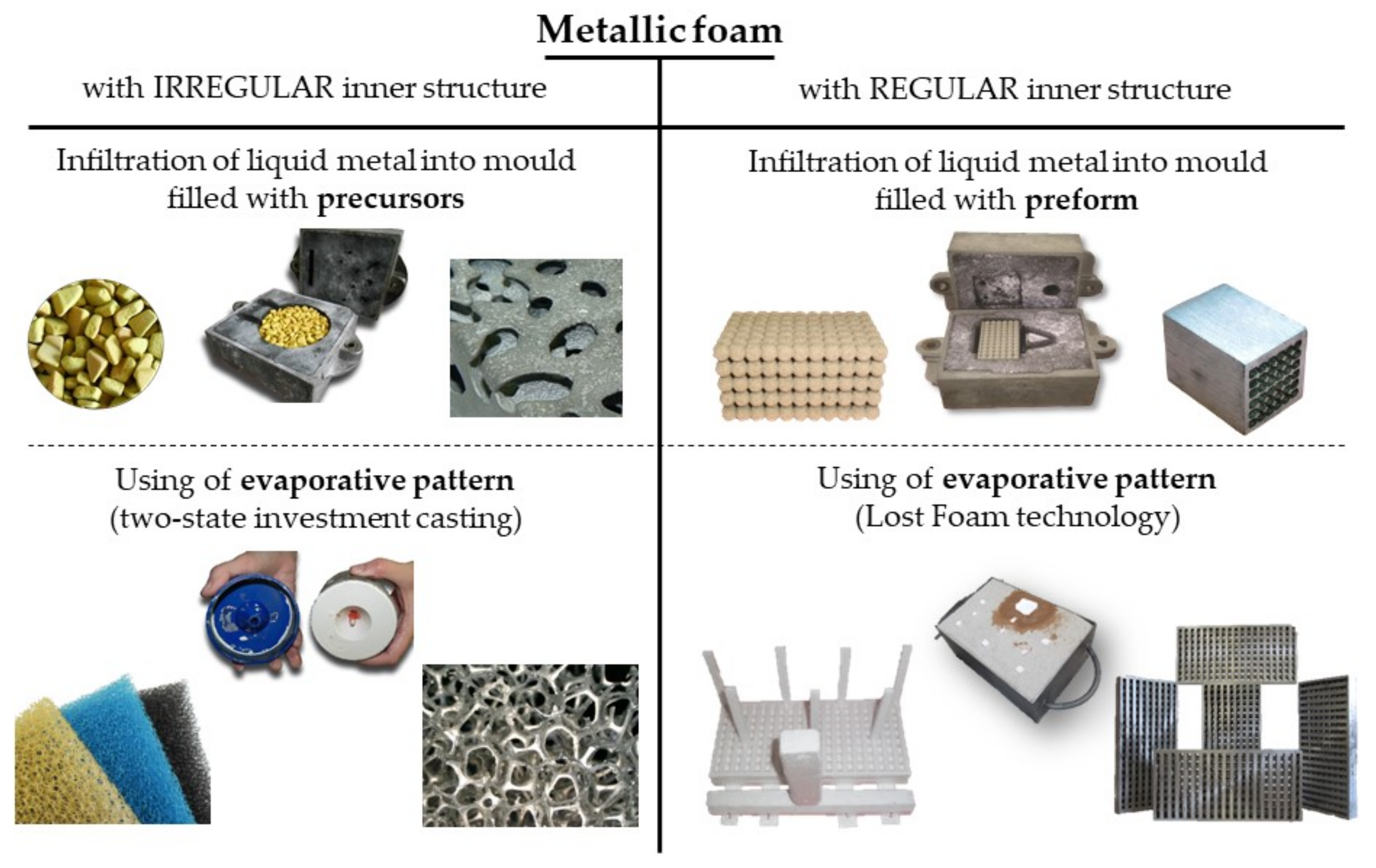




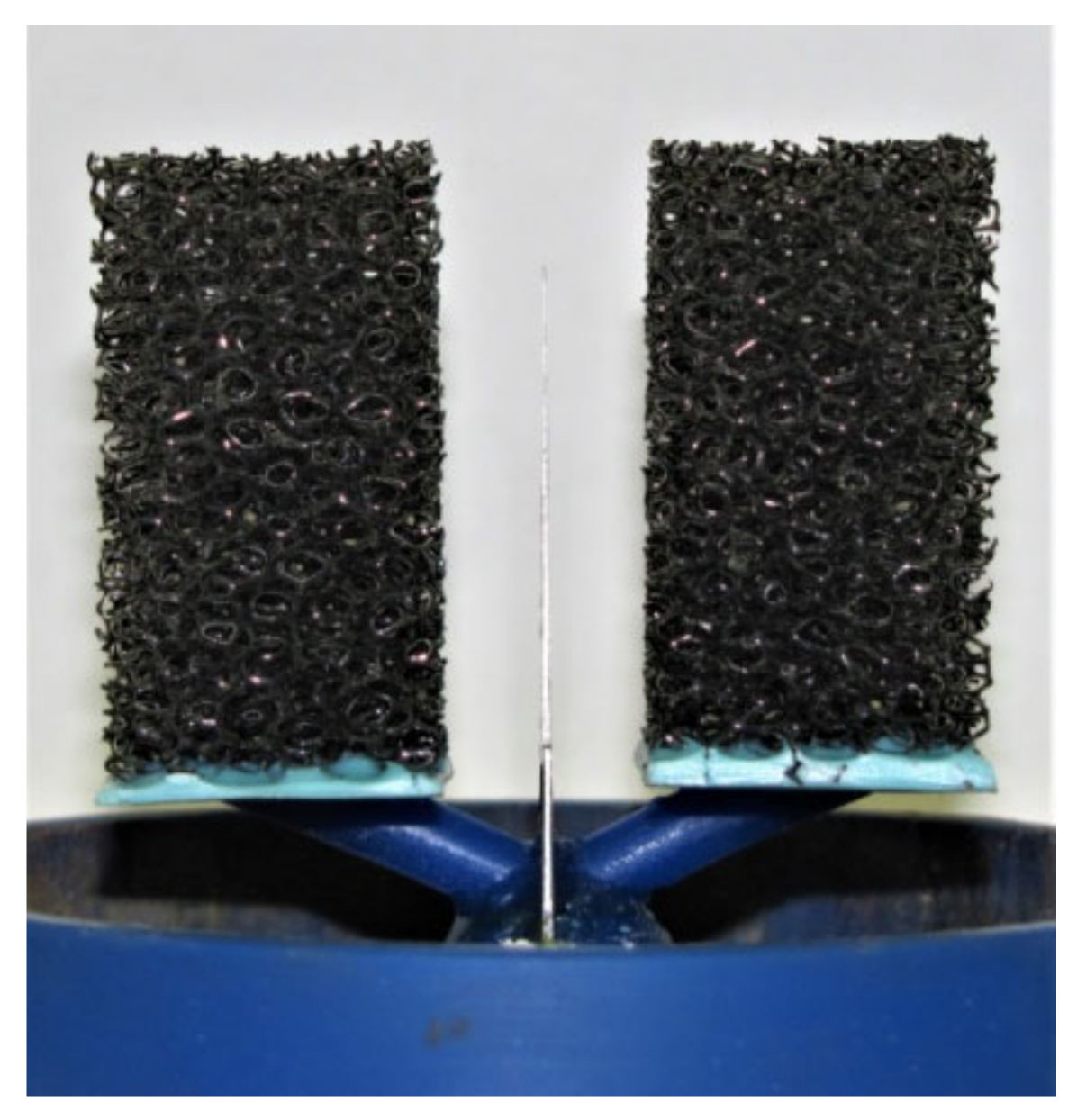

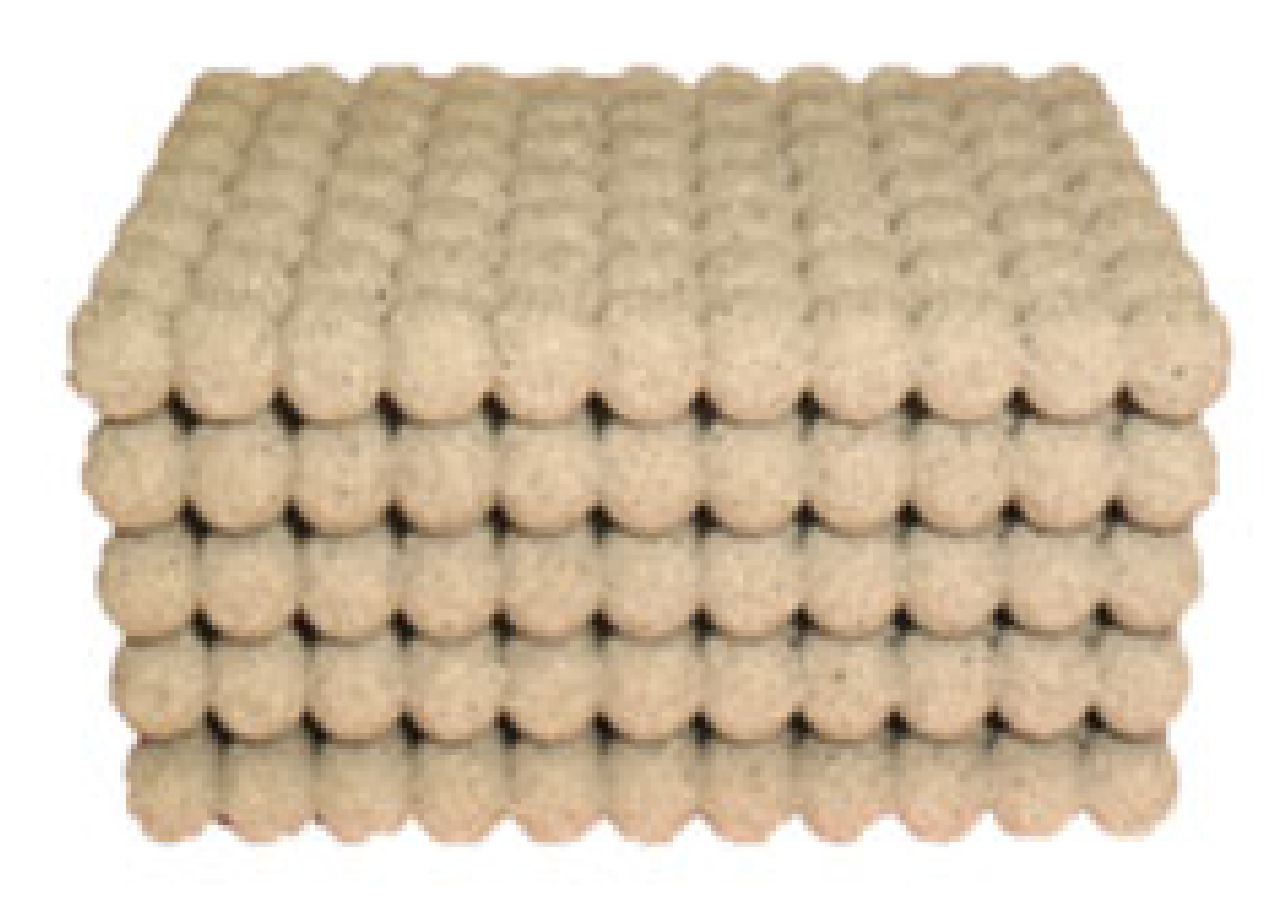

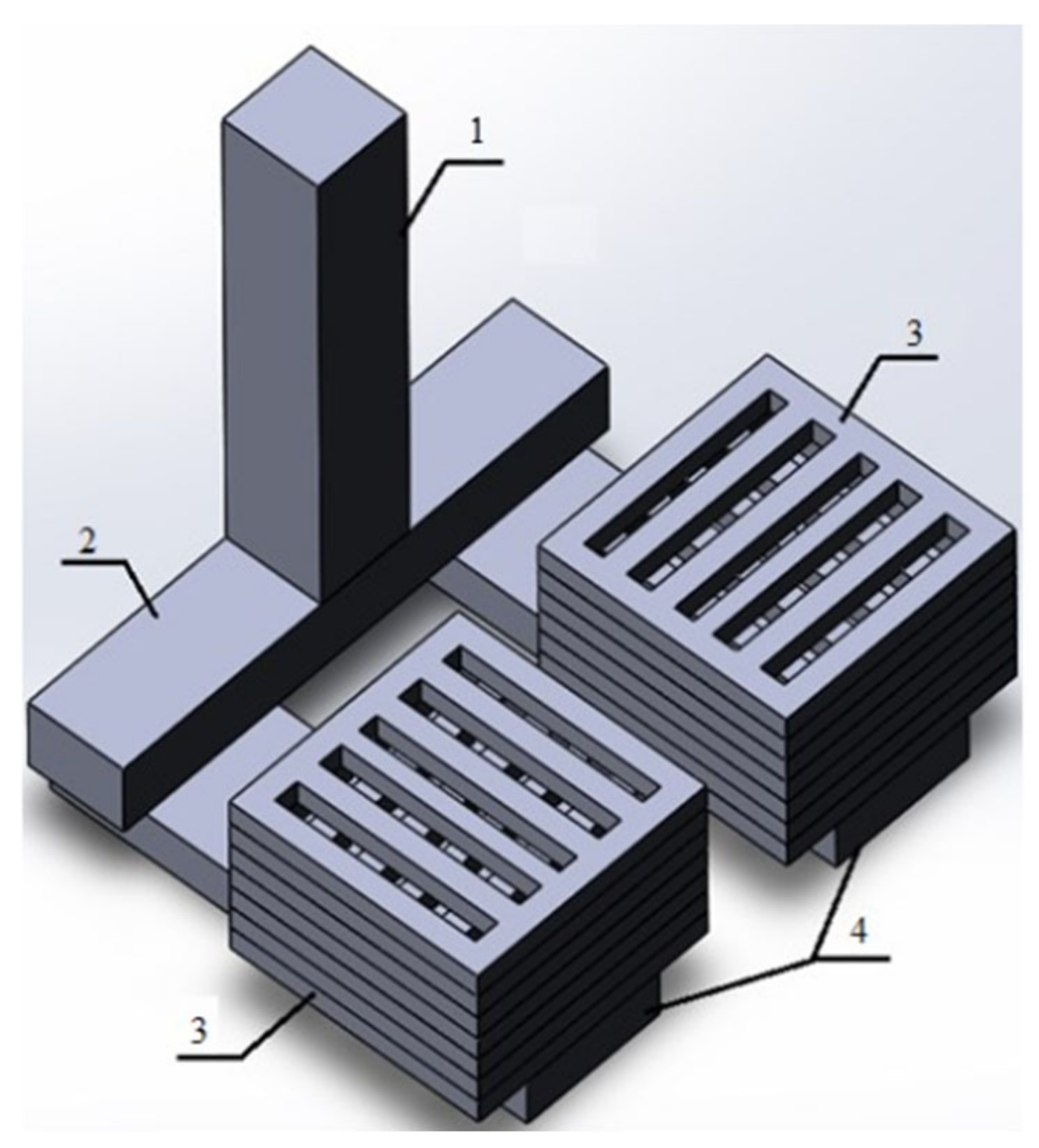
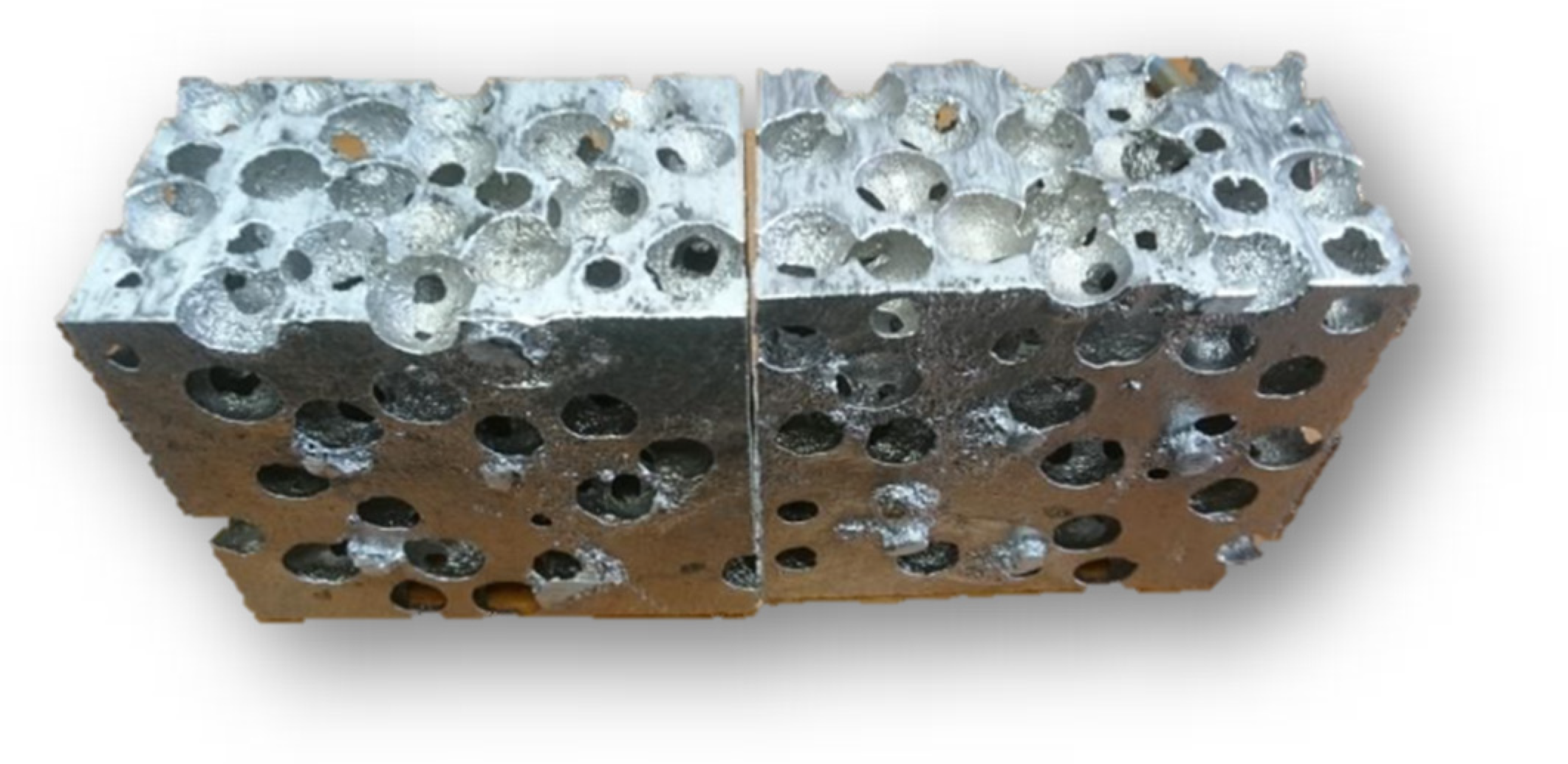
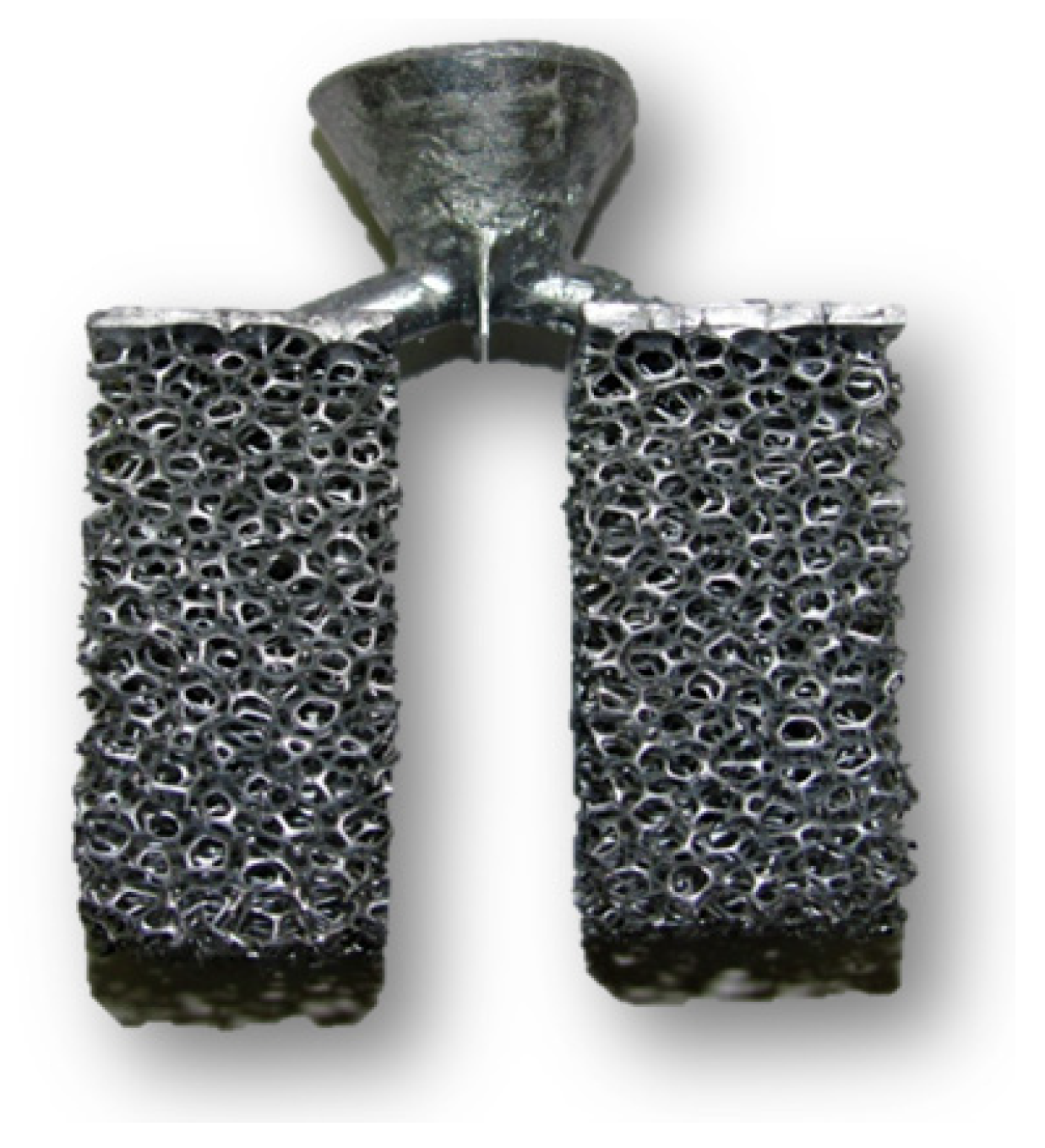
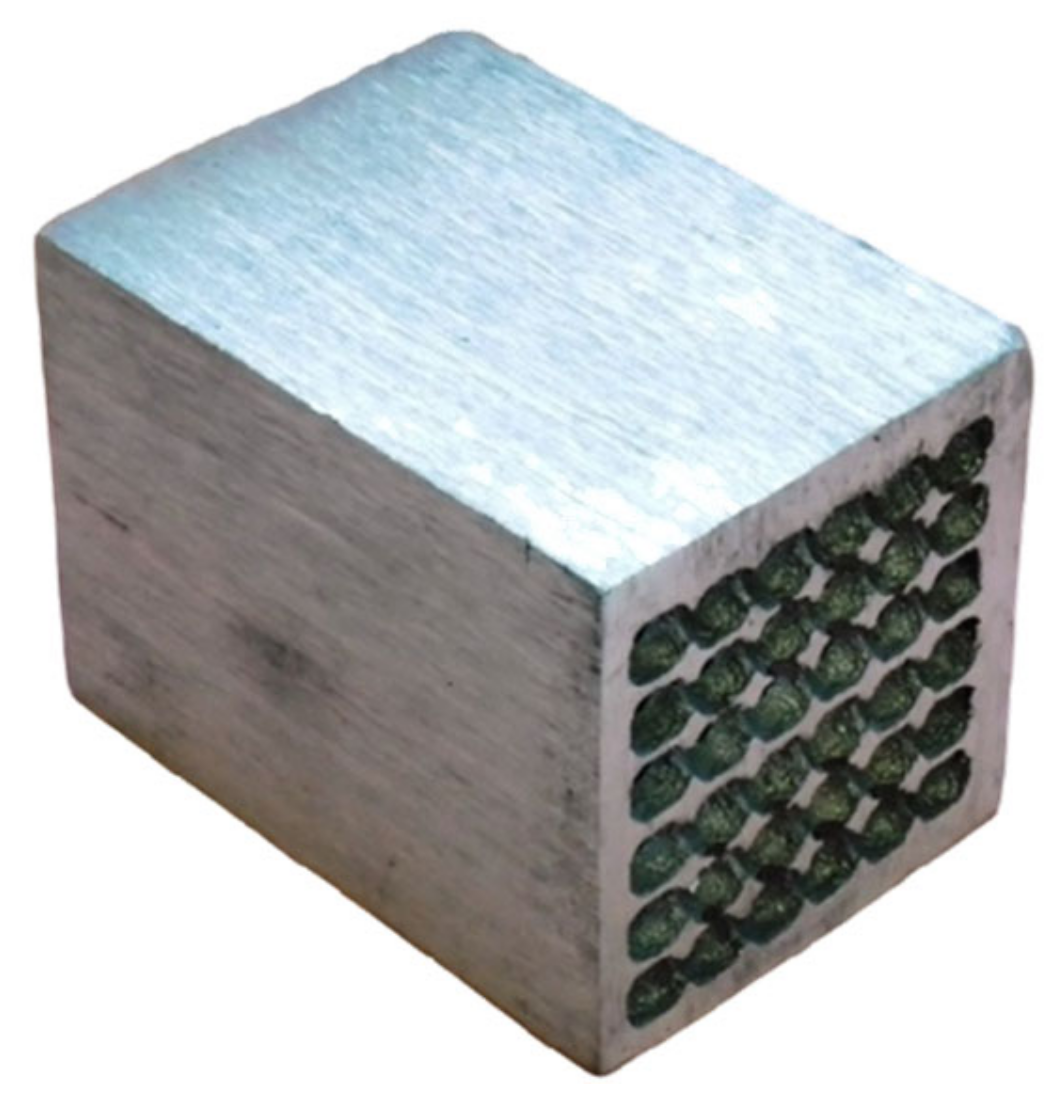
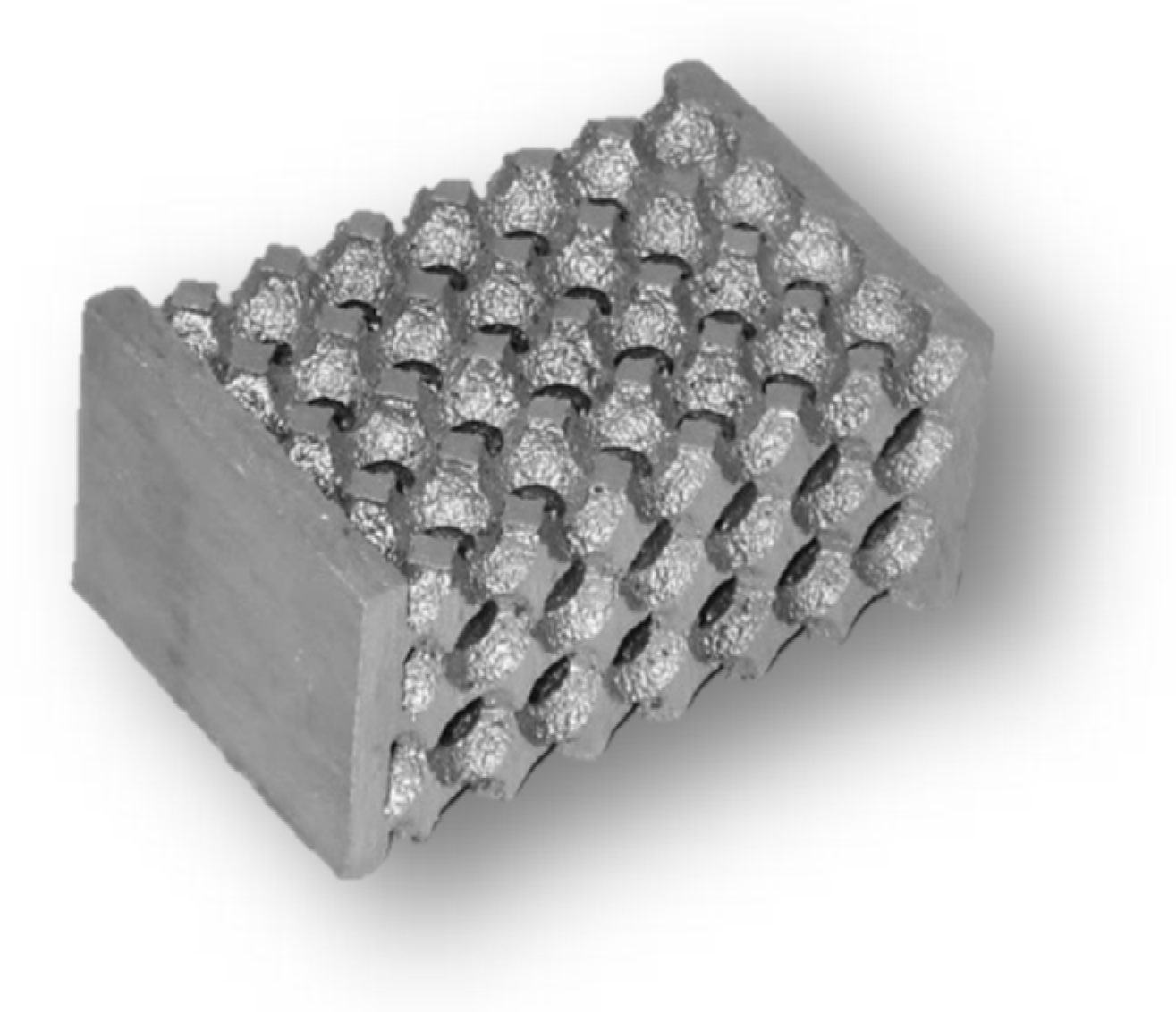
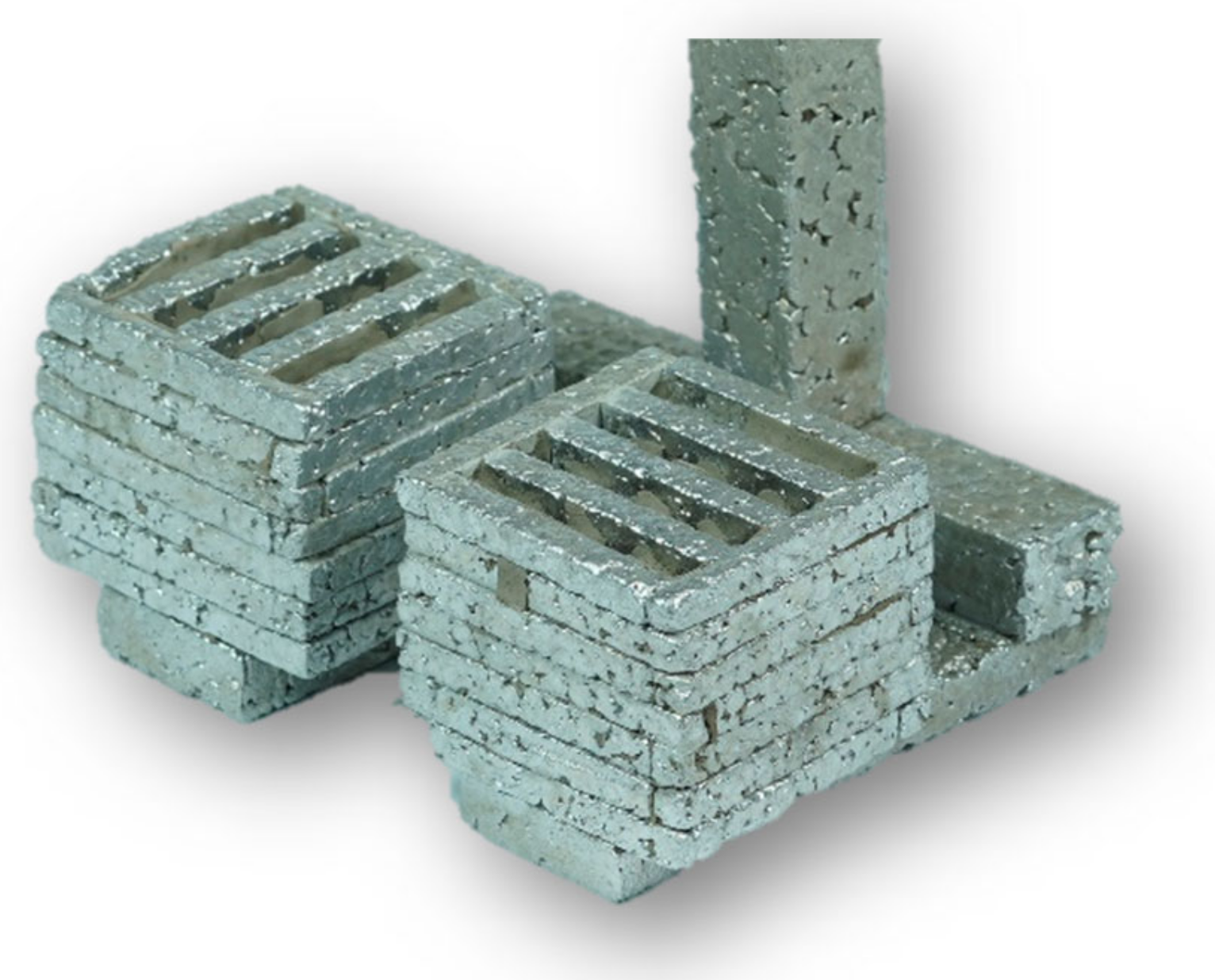
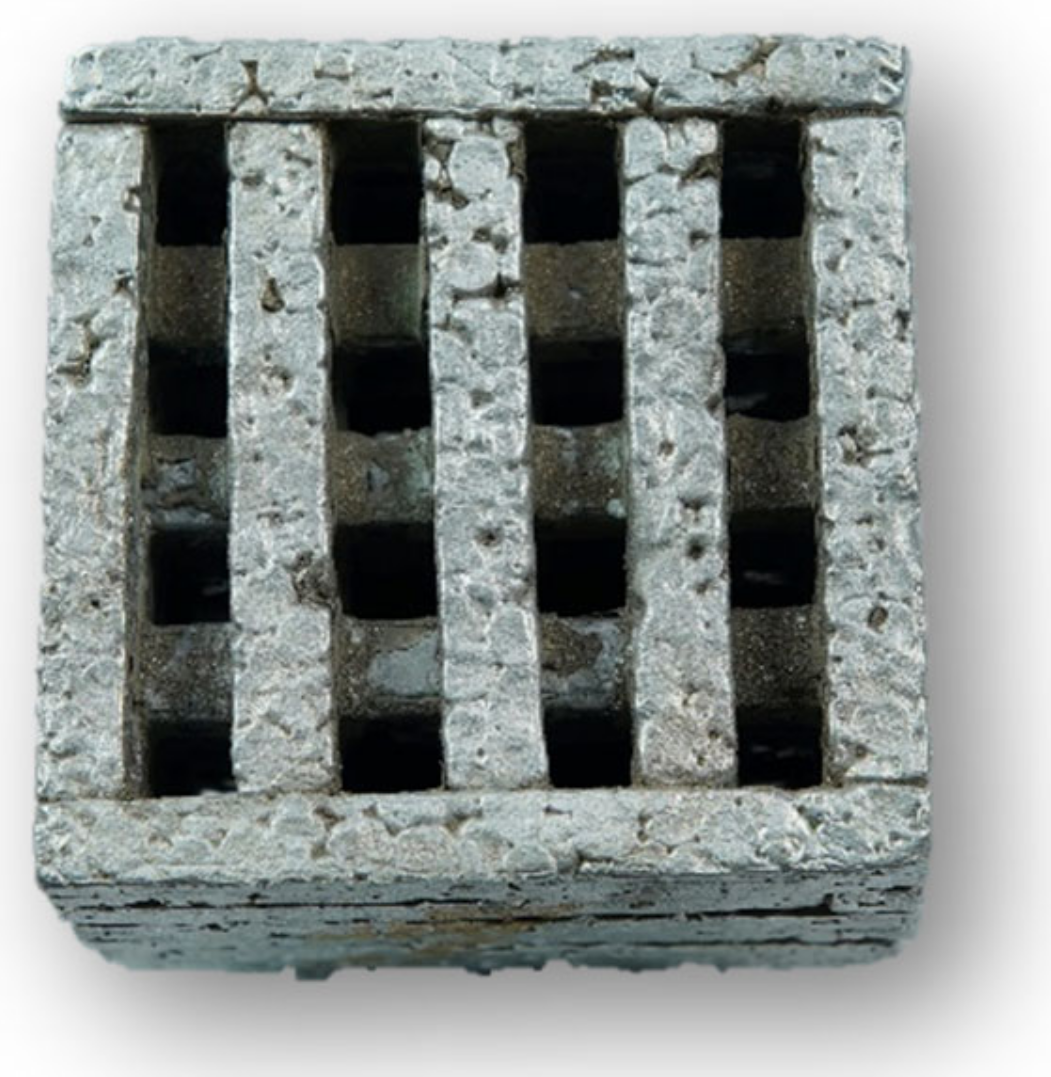
| Technology | Moulding Material | Pattern | Material of Precursors/Preform | Casting Material |
|---|---|---|---|---|
| Infiltration of liquid metal into the cavity filled with precursors | Sand mould | Permanent pattern | Ceramic | Al-Si, cast iron |
| Croning technology | Al-Si, Cu-Sn, cast iron | |||
| Furan no-bake | Al-Si, Cu-Sn, cast iron | |||
| PUR Cold Box | Al-Si, Cu-Sn, cast iron | |||
| Salt | Al-Si, Cu-Sn | |||
| Two-stage investment casting process | Plaster | Polyurethane evaporable pattern | – | Al-Si, Cu-Sn |
| Infiltration of liquid metal into a cavity filled with a preform | Sand mould | Permanent pattern | PUR Cold Box | Al-Si, Cu-Sn, cast iron |
| Technology using a disposable evaporable pattern | Silica sand | Polystyrene evaporable pattern | – | Al-Si |
| Name | Number of Pores (PPI) | Density (kg∙m−3) | Cell Diameter (µm) |
|---|---|---|---|
| Bulpren S 28190 | 30 | 23–27 | 1650–2150 |
| Bulpren S 28280 | 20 | 23–27 | 2300–3300 |
| Bulpren S 32450 1 | 10 | 27–31 | 3800–5200 |
| Technology | Pore Content (%) | Pore Ø (mm) | The Main Advantage of the Technology | |
|---|---|---|---|---|
| Infiltration of liquid metal into the cavity filled with precursors | Ceramic | 50–60 | 8–16 | Available material |
| Croning technology | 60–70 | 10–30 | Use of waste material | |
| Furan no-bake | 50–60 | 15–20 | Good collapsibility | |
| PUR Cold Box | 50–60 | 10 | Precursors of the same shape and size | |
| Salt | 50–60 | 18–22 | Solubility of precursors in water | |
| Two-stage investment casting process | Up to 97 | 4–5 | Achieving high pore content | |
| Infiltration of liquid metal into a cavity filled with a preform | 45–55 | 10 | Regular distribution of internal cavities | |
| Technology using a disposable evaporable pattern | 50 | 6 | Regular distribution of internal cavities | |
Publisher’s Note: MDPI stays neutral with regard to jurisdictional claims in published maps and institutional affiliations. |
© 2021 by the authors. Licensee MDPI, Basel, Switzerland. This article is an open access article distributed under the terms and conditions of the Creative Commons Attribution (CC BY) license (https://creativecommons.org/licenses/by/4.0/).
Share and Cite
Kroupová, I.; Gawronová, M.; Lichý, P.; Merta, V.; Radkovský, F.; Janovská, K.; Nguyenová, I.; Beňo, J.; Obzina, T.; Vasková, I.; et al. Preparation of Cast Metallic Foams with Irregular and Regular Inner Structure. Materials 2021, 14, 6989. https://doi.org/10.3390/ma14226989
Kroupová I, Gawronová M, Lichý P, Merta V, Radkovský F, Janovská K, Nguyenová I, Beňo J, Obzina T, Vasková I, et al. Preparation of Cast Metallic Foams with Irregular and Regular Inner Structure. Materials. 2021; 14(22):6989. https://doi.org/10.3390/ma14226989
Chicago/Turabian StyleKroupová, Ivana, Martina Gawronová, Petr Lichý, Václav Merta, Filip Radkovský, Kamila Janovská, Isabel Nguyenová, Jaroslav Beňo, Tomáš Obzina, Iveta Vasková, and et al. 2021. "Preparation of Cast Metallic Foams with Irregular and Regular Inner Structure" Materials 14, no. 22: 6989. https://doi.org/10.3390/ma14226989
APA StyleKroupová, I., Gawronová, M., Lichý, P., Merta, V., Radkovský, F., Janovská, K., Nguyenová, I., Beňo, J., Obzina, T., Vasková, I., Lána, I., & Rygel, J. (2021). Preparation of Cast Metallic Foams with Irregular and Regular Inner Structure. Materials, 14(22), 6989. https://doi.org/10.3390/ma14226989







